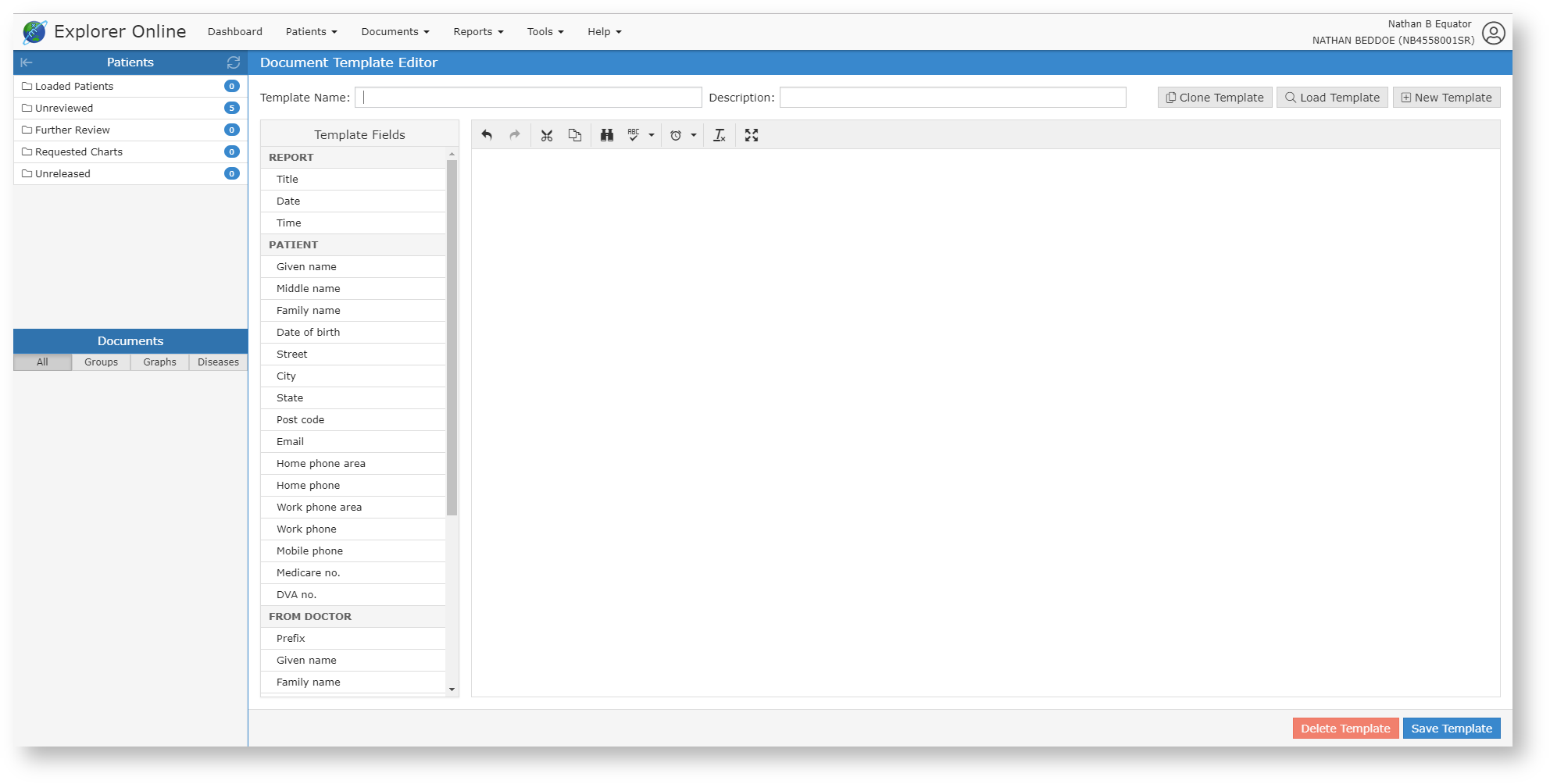- Created by Jason F, last modified by Emma Day on Sept 15, 2022
You are viewing an old version of this page. View the current version.
Compare with Current View Page History
« Previous Version 120 Next »
Overview
This article will cover the basic functionality of Medical-Objects Explorer Online. If you have any questions or require any further information, please contact the Helpdesk on (07) 5456 6000.
Medical-Objects Explorer Online is a web-based solution that allows you to send and receive patient documents from your own personal web browser on a tablet, desktop or laptop device. Explorer Online was designed to run on desktops, laptops and modern tablets running Windows, MacOS or Linux. Mobile phones are not currently supported. Please take note of the browser requirements below.Requirements
Supported Browsers
PROMs User Guide
When first loading Explorer Online you will be presented with a login screen. Simply enter in your username and password and click login to proceed. Once logged in you can Logout again or Change Provider by simply clicking on the User Menu in the top right hand corner of the screen. The Dashboard is the default page that will appear once you have logged into Explorer Online. The Dashboard is split into three sections: Navigation Menu, Sidebar and the main content area. This is the main navigation menu. The menu is dynamically built up based on what features your server has enabled and what permissions your user account has. If a menu item is missing you may need to call the Helpdesk to correct your user permissions or enable a server feature. The User Menu is the menu in the top right hand corner. This will display the server you've logged into and also which provider you selected at login. When you click on the User Menu a drop down will appear with menu options related to your user account. Warning Please contact us to enable this feature on your account.Logging in and out
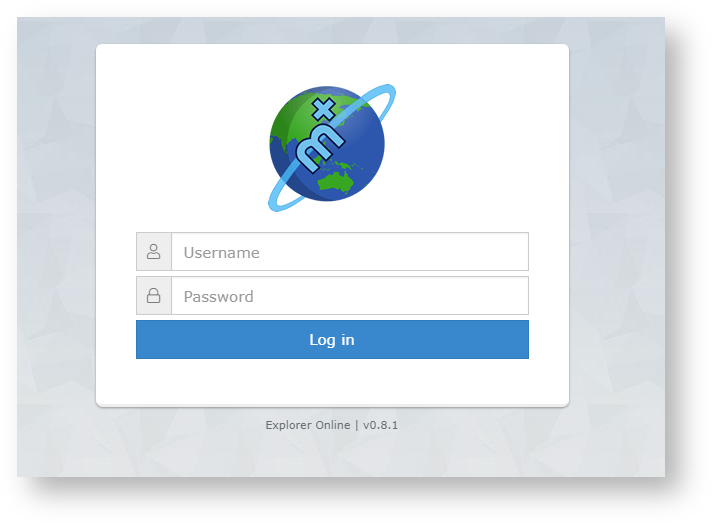
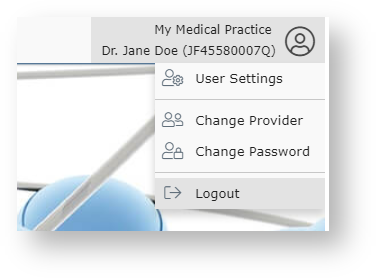
Dashboard Layout
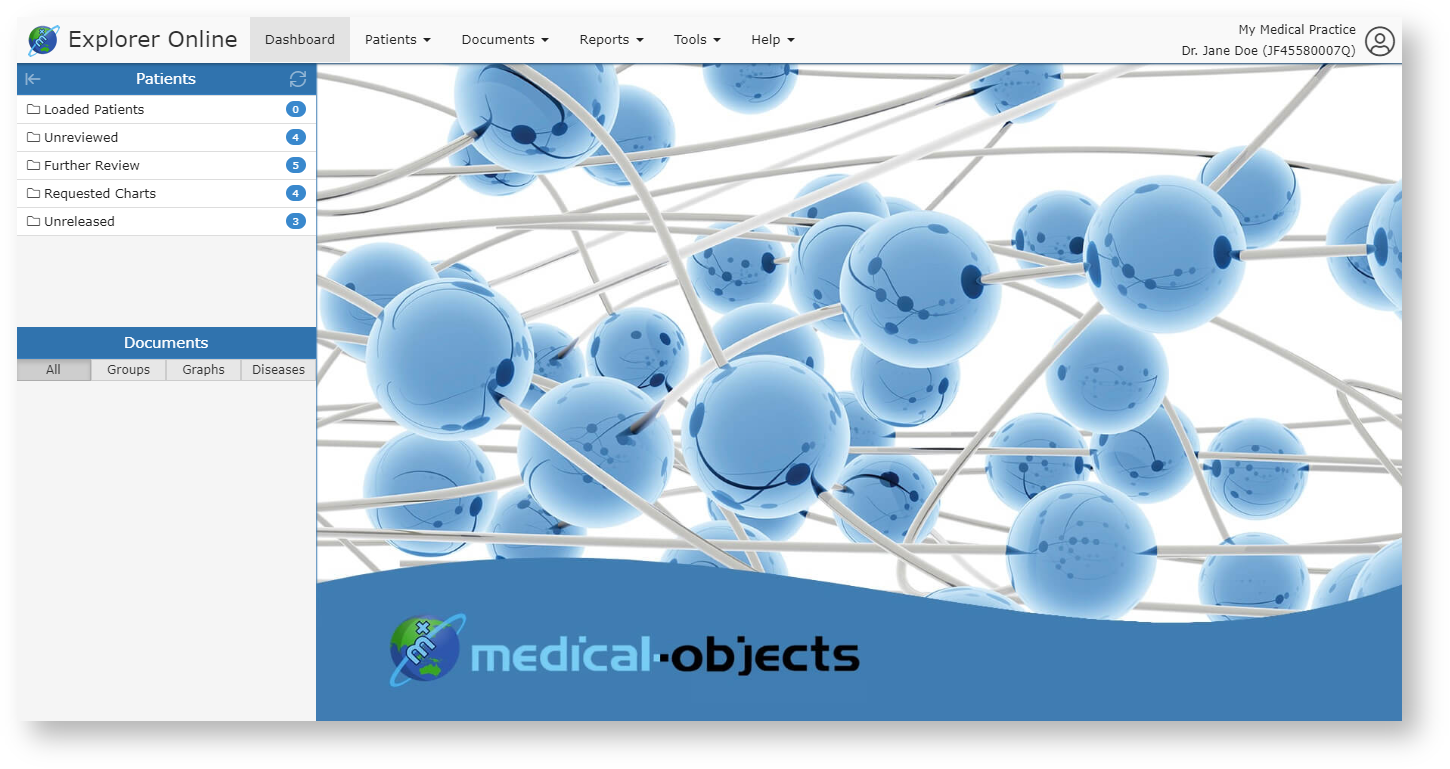
Navigation Menu

User Menu

Email Notifications
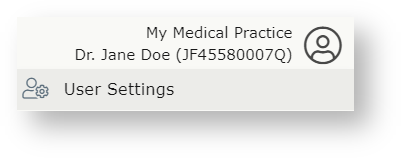
The Sidebar is a feature that allows you to access and manage your patient documents. The Sidebar is split into two sections: Patients and Documents. If you're using Explorer Online on a smaller screen you have the option to collapse the sidebar by clicking the collapse icon The Patients section of the Sidebar consists of individual folders which contains patient documents. The folders will list each unique patient that has a document for that folder. The count to the right is the amount of patients in the folder and not the amount of combined documents. Hovering over a folder will reveal a grid icon ( To refresh the contents of the folders simply click the refresh button ( Contains any patients you've done a lookup on or retrieved all documents for. You can remove a patient from this list by clicking the remove icon ( If you want to clear the folder and remove all patients you can click on the clear icon ( Contains patient documents that have been parked. A document can be parked by clicking the 'Park' document action button. Documents in this folder can only be accessed by the provider who made the original 'Park' request. To remove a document from this folder click the 'Unpark' document action button. Contains patient documents with the requested chart status. A document can be moved to the Requested Charts folder by clicking the 'Request Chart' document action button. Any user in your practice’s Explorer Online software, who has the granted permissions to view results, can access documents in this folder. For more information on setting user permissions, see our Explorer Online Admin Guide or please contact the Helpdesk on (07) 5456 6000. Practices can decide how to use this feature in their own workflows. For example, doctors can use this option as a request for staff to gather medical charts after receiving a message on a patient. Another example might be when a doctor receives an eReferral, and then clicks 'Request Chart' so that staff can be ready with the referral on hand prior to a consultation with a patient. Upon completion of the workflow relating to the document, staff can then select the 'Cancel Chart' document action button to remove it from the Requested Charts folder. Contains patient documents that have not yet been released. Documents in this folder can either be released or deleted. An unreleased document will have the following red text in the document title to indicate that it has not yet been released. Unreleased documents are created by ticking the 'For Approval Before Delivered' option when sending a document. Contains a recent list of documents that you have created, This includes both progress notes and documents that you have sent. You can clear this folder by hovering over it and clicking on the Clear Folder button ( The Documents section will list all the documents for the selected patient that correspond to the folder the patient is in. For example if you select a patient in the Unreviewed folder, all unreviewed documents for that patient will be listed. Hovering over the Documents section will reveal a grid icon ( Abnormal results will show as red in the documents list.Sidebar
![]() found on the left side of the Patients header. You can then expand the Sidebar again by clicking the
found on the left side of the Patients header. You can then expand the Sidebar again by clicking the ![]() icon.
icon.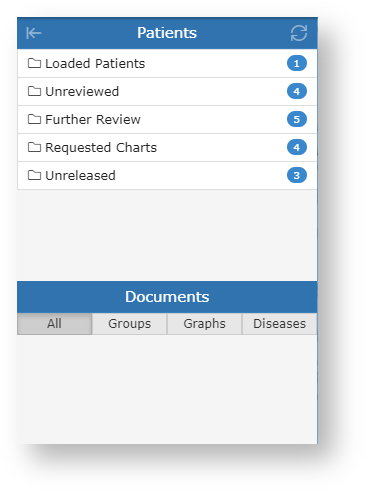
Patients
![]() ). This button will load all the documents in that folder into a grid. From there you can then perform bulk actions on the documents such as printing or forwarding to another provider.
). This button will load all the documents in that folder into a grid. From there you can then perform bulk actions on the documents such as printing or forwarding to another provider.![]() ) in the title bar.
) in the title bar. Loaded Patients ![]() ).
).![]() ).
).Unreviewed Contains patients that have unreviewed documents. Selecting documents from this folder will give you the option to mark the document as reviewed. Further Review ![]()

Requested Charts ![]()
![]()
Unreleased ![]()
![]()
Created ![]() ).
).Documents
![]() ). This button will load all the documents listed into a grid. From there you can then perform bulk actions on the documents such as printing or forwarding to another provider.
). This button will load all the documents listed into a grid. From there you can then perform bulk actions on the documents such as printing or forwarding to another provider.
Managing Patients
Registering a Patient
To register a patient, select the Patients button in the top navigation and then click Register Patient on the dropdown.
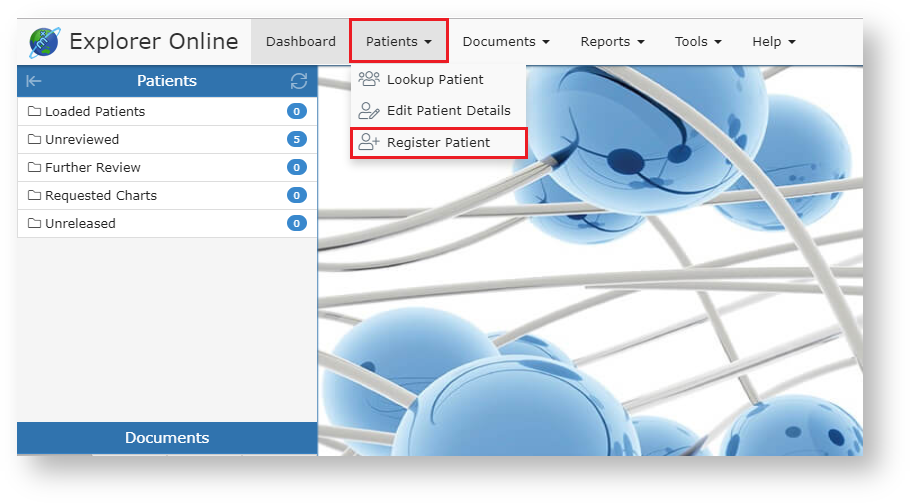
Once clicked, a window will pop up with text fields to input patient information, as seen in the screenshot below.
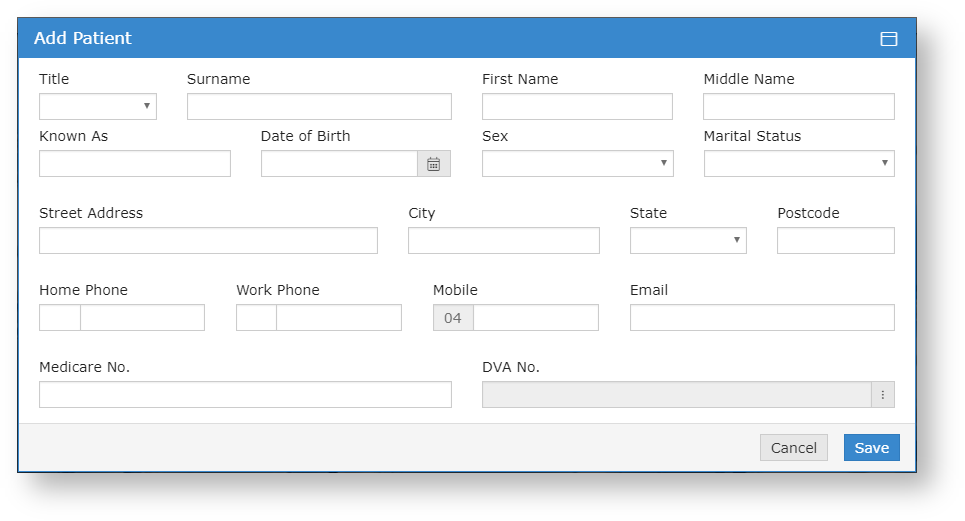
The required fields for registering a patient are Surname, First Name, and Date of Birth. While they are the only required fields, it's suggested that you fill as many of them out as possible, so you have as much information on documents as possible.
Editing a Patient
To edit a patient, go to the Patients dropdown in the top navigation bar, and then click Edit Patient Details.

This will take you to the Patient Lookup window. The patient lookup window is used to search for current patients that your practice has previously created with Medical-Objects. You have three different options in which to search for, their name, ID or lab number. You can change these on the dropdown to the right of the search field. You can then type a search term into the text field, press the Search button and if all is well, you will see your patient.
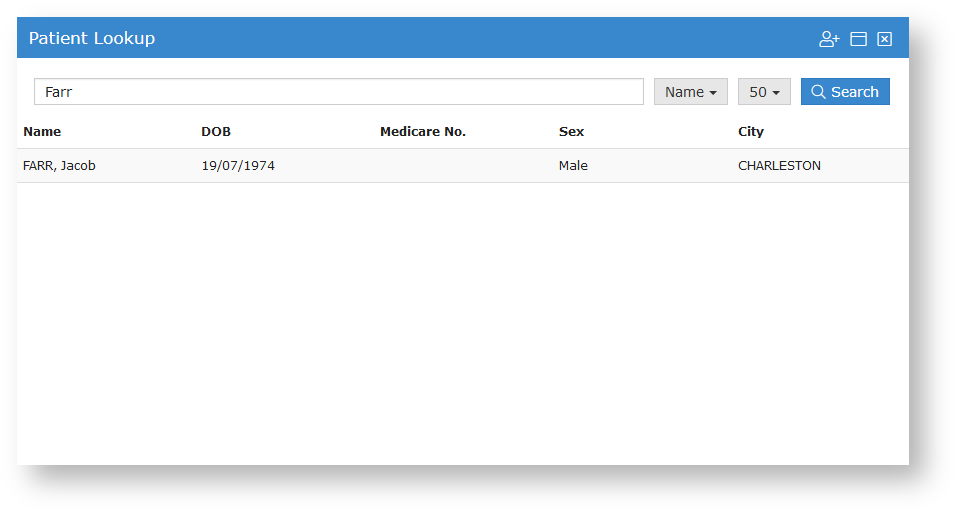
Once you have found your patient, you can then select the patient you wish to view, and then you will see the edit screen. Fill out the fields that you wish to change or add, and then click the Save button.
Adds the document to the Requested Charts sidebar folder. To list documents in a grid allowing for bulk actions you can simply click on the grid icon ( You can select multiple documents in the grid and then perform an action on the selection. Currently the bulk actions available are: Documents that appear in your Unreviewed sidebar folder will need reviewing so that the sender of the document receives an acknowledgement. Marking a document as reviewed can be done one of two ways. Both methods will only be accessible if you're viewing the document from within the Unreviewed sidebar folder.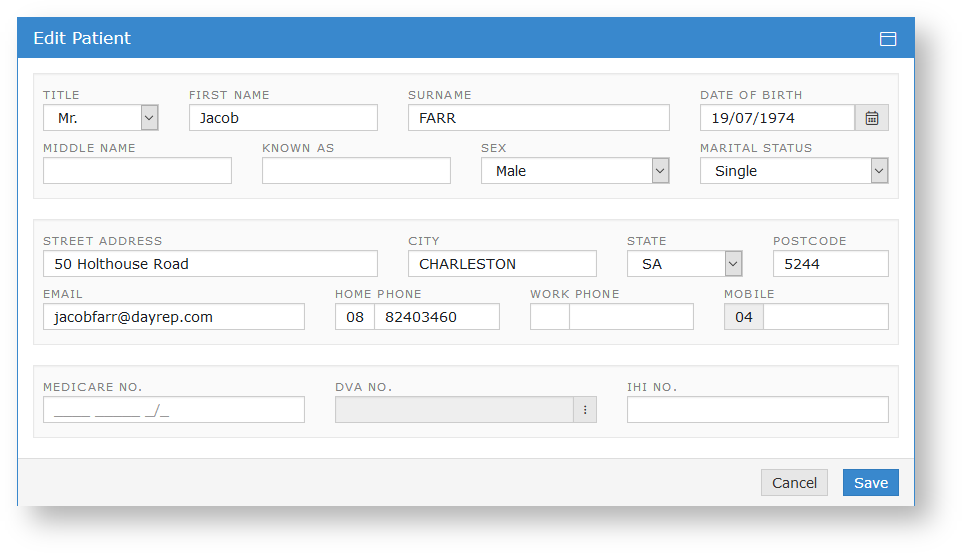
Viewing Documents

Document Actions
Park Adds the document to the Further Review sidebar folder. Unpark Removes the document from the Further Review sidebar folder. Request Chart Cancel Chart Removes the document from the Requested Charts sidebar folder. Create Response Brings up the Send Document form with the patient, ordering provider and copies to fields pre-populated from the document. History Loads the transaction history of the document. Forward Allows you to forward the document to another provider. Print Allows you to print the document. Release This button is only visible for unreleased documents. It will release the document and send it to the addressed provider/s. Delete This button is only visible for unreleased documents. It will delete the unreleased document. Mark as Reviewed This button is only visible when viewing a document from within the Unreviewed sidebar folder. It will mark the document as reviewed. All Documents This button will show up when viewing a document from any sidebar folder except the Loaded Patients folder. When clicked it will load all the documents for the patient of the currently selected document. Viewing documents in grid
![]() ) in the sidebar from either the documents section or when hovering over each folder.
) in the sidebar from either the documents section or when hovering over each folder.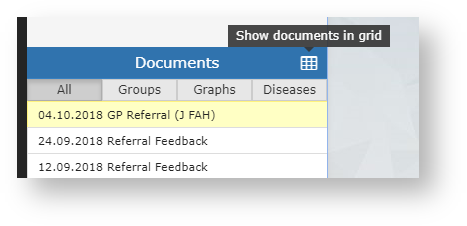
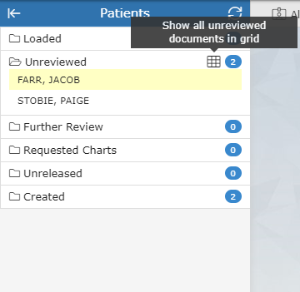

Bulk Actions
Marking documents as reviewed
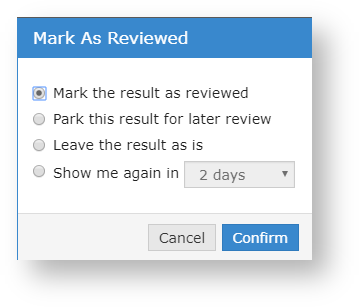
Sending a Document
Provider Lookup
The Provider Lookup feature allows you to easily search details and check if a provider is routable (setup to receive sent results) before you send a document.
2. Enter the details of the provider in the search box, enter the surname first if you are searching by the Name search type. Press the Search button or hit the enter key to load results. 3. You can check to see if the provider number is routable by looking for the green globe in the Name column.
Please ask your Confluence administrator to update the license for the MultiExcerpt App for Confluence .
Admin Info: The error is: license VERSION_MISMATCH
Having issues finding a doctor? Try the following: - Try a partial name search if you're unsure of the full name. "Bob Johnson" can be found by searching for "John B" or "Jo Bob". - If the doctor has a space in their surname, try leaving out the space. For example, "Bob Von Doctor" can by found by searching "VonDoctor" as the surname.
- Change the search type to Organisation, and search for the practice name.
You can also complete the Provider Lookup when completing the Addressing Details when sending a document (see below).
Sending a Text Document
To send a document, you can click the Documents → Document (Under Send) in the navigation bar at the top.

Most of filling out the document information is done automatically. If you have a patient selected in the Patients Sidebar then the Patient Details will already be filled out. If not, then you can click the Find button in the Patient Details section and find the patient details you need. You can also Add a patient on this screen, if the patient whose document you want to send isn't in the system yet.
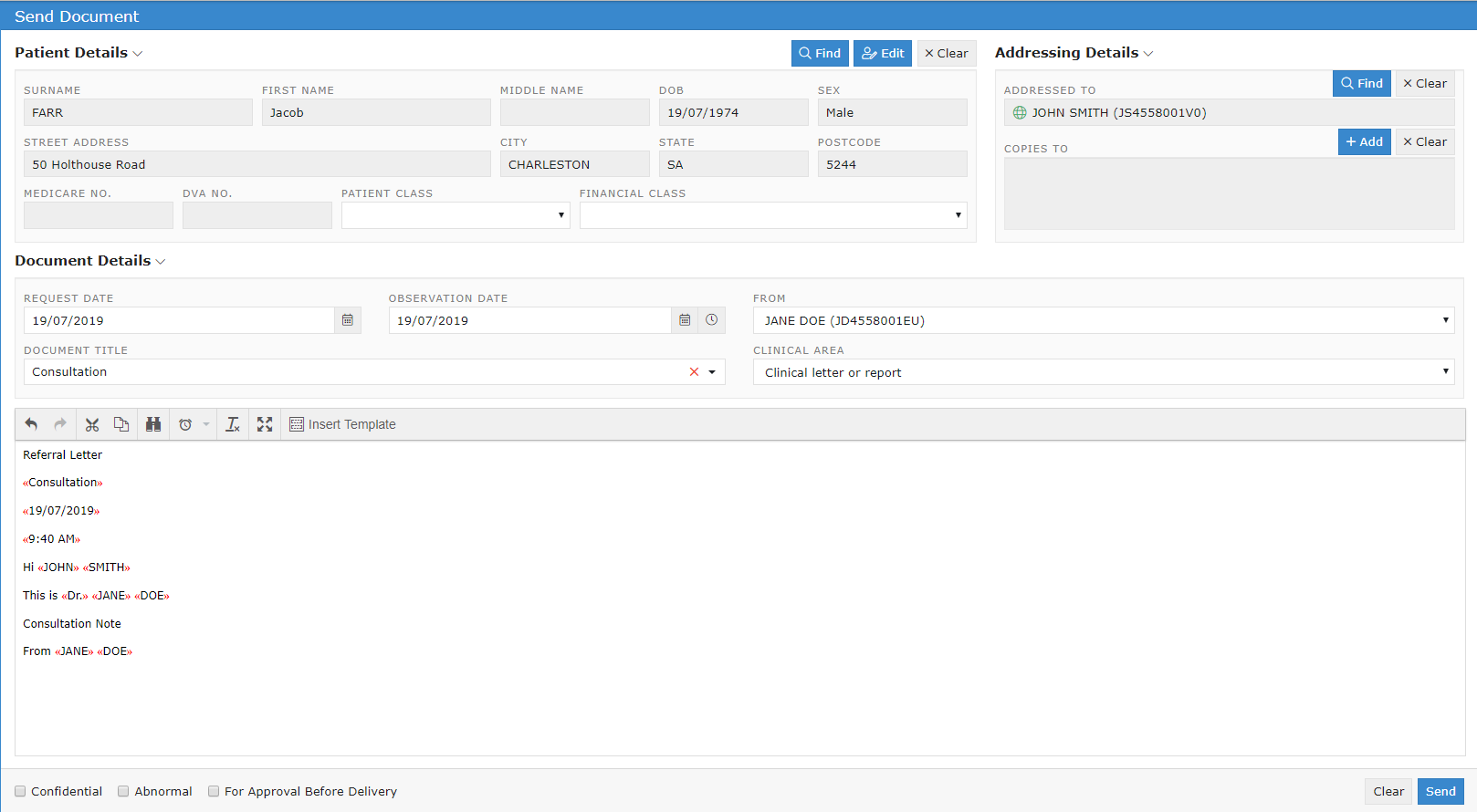
Addressing Details
To add a practitioner to send to, you can go across to the Addressing Details section. To add providers, click the Find and Add buttons, to either add the main provider, or to send copies to certain providers. This button will take you to the Provider Lookup window where you can find the providers you wish to send to.
Document Details
You can then fill in the Document Details section with the specific details of your document. One of the special additions is the use of Templates, which you can click the Insert Template button to quickly add content to your document.
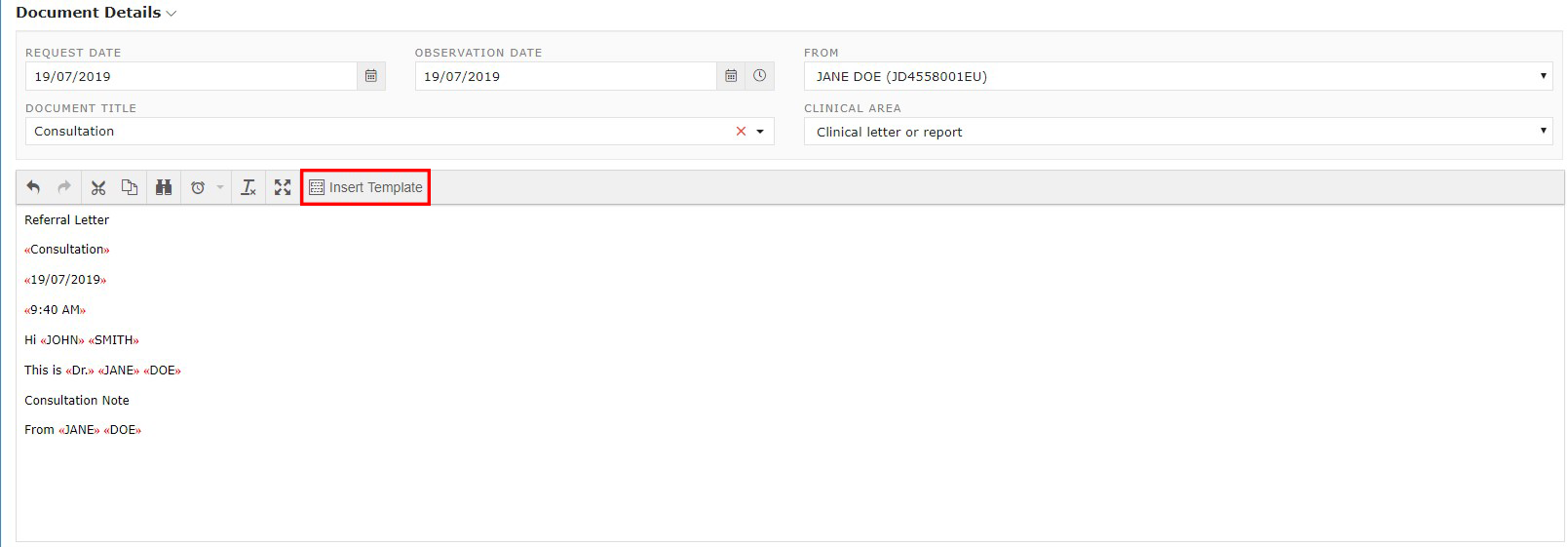
Unreleased Documents
An unreleased document can be thought of as a draft before sending the document. You may want to keep it in your system, but not send it off to the Addressee. If this is the case, then you can click the For Approval Before Delivery button in the bottom right of the Send Document screen.
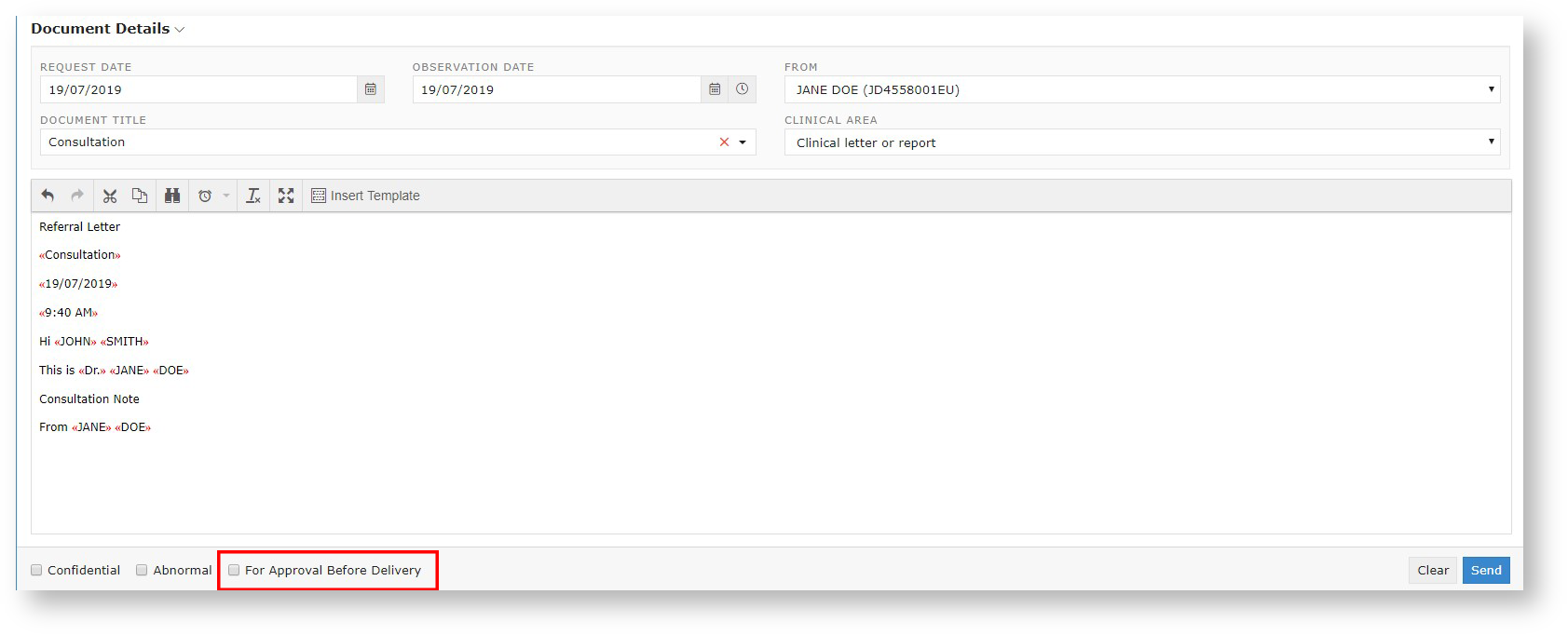
This will then save it into the Unreleased folder in the Patients section of the Sidebar.
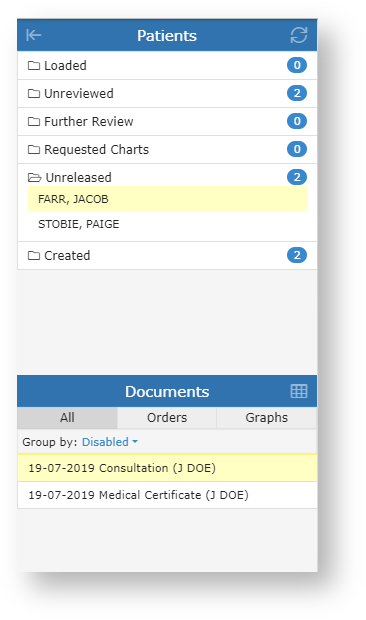
Sending a PDF Document
Sending a PDF document is very similar to sending a plain document. The main difference is that you aren't sending text, you are sending an attached PDF file. All of the Addressing and Patient detail setting is the same, the main difference is in the Document Details, where you normally would type in the content, there is now a PDF Viewer.
To send a PDF document, you can click the Documents → PDF Document (Under Send) in the navigation bar at the top.
To open a PDF, click the Browse button:

To send the PDF document, simply hit the Send button once all the information has been included,
Sending a document with an image
To send images you can click the Documents → Images (Under Send) in the navigation bar at the top.

To add the images you would like to send, click the Browse Images button (below). To send the images, hit the Send button once all the information has been included.
Sending a Word/RTF Document
Currently it's only possible to send a plain text document OR a PDF document. If you wish to send a Microsoft Word document or any other format you have the option to save the document as a PDF (for example from Microsoft Word) and then send it as a PDF.
We're currently looking into adding the ability for sending other document types.
Creating a Progress Note
A Progress Note is an internal document for a patient that is stored against the patient's file. You can create a Progress Note for a patient from the Documents menu in the top navigation.
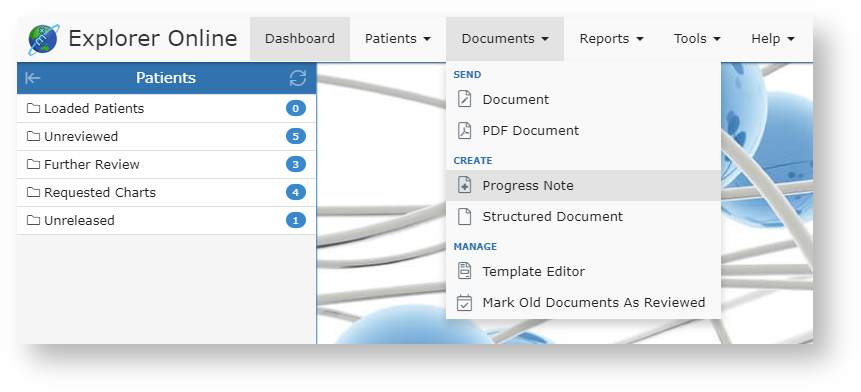
If you don't already have an active patient, you will be prompted to find a patient. Once a patient is selected you will be prompted with the Progress Note window.

A Progress Note can contain plain text or a PDF document, but not both. Select which document content you'd like to add via the Text or PDF mode buttons in the top right hand corner.
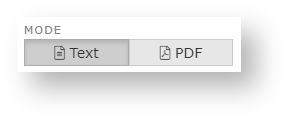
Document Template Editor
To get to the Document Template Editor, you can click Documents → Template Editor (Under manage). A screen should show up with text editors, and a sidebar.
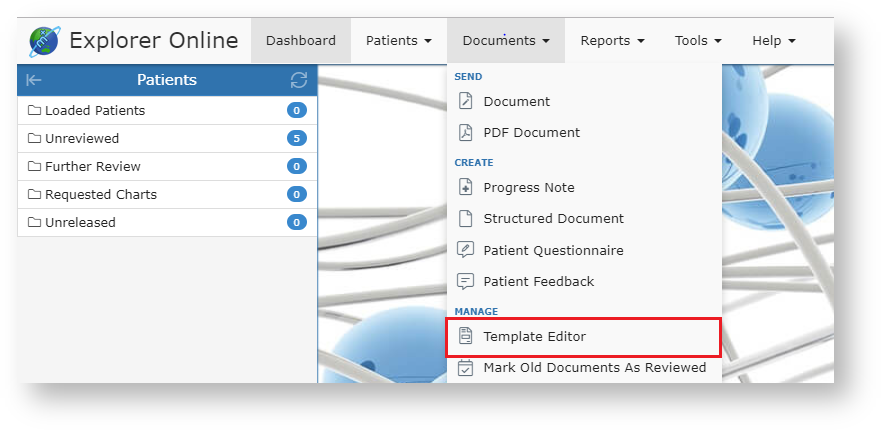
After clicking that button, it should take you to the screen below.
Creating a Template
A document template must have a template name, description and some content.
Template Name
The template name is what you'll see on your end to identify each template. You should call it something descriptive, but also keep it concise.
Description
The description will show as a subheader when selecting the template. This is generally longer than the Template name and can help when you have a few very similar template names.
Content
The content is what will automatically be generated into the document when you select a template. You can see on the left of the template editor a "Template Fields", these are special fields, that when you import the template into your document, they will fill out with the details you've included. So if you have selected a patient named "John Doe", then the Given Name template field will be "John" and the Family Name field will be "Doe". You can also write plain text with no template fields if that is what you want.
Submitting a Template
Once you have filled out the required fields, you can create the template by clicking the "Save Template" button, highlighted in the below screenshot.
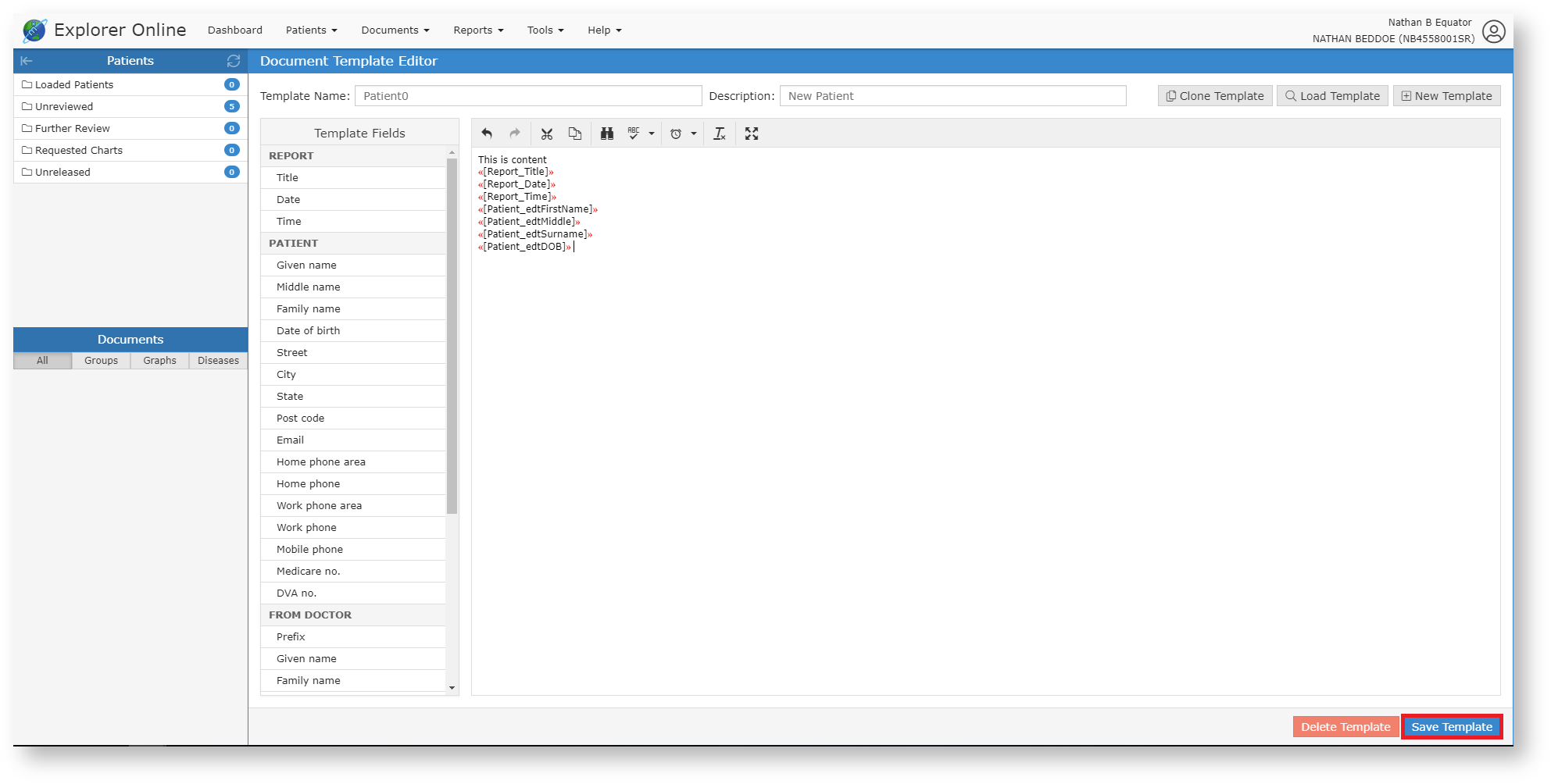
Editing an existing Template
To edit an existing template you need to:
Load a template
Select a template from the proceeding screen by clicking on the desired template, and clicking Load in the bottom right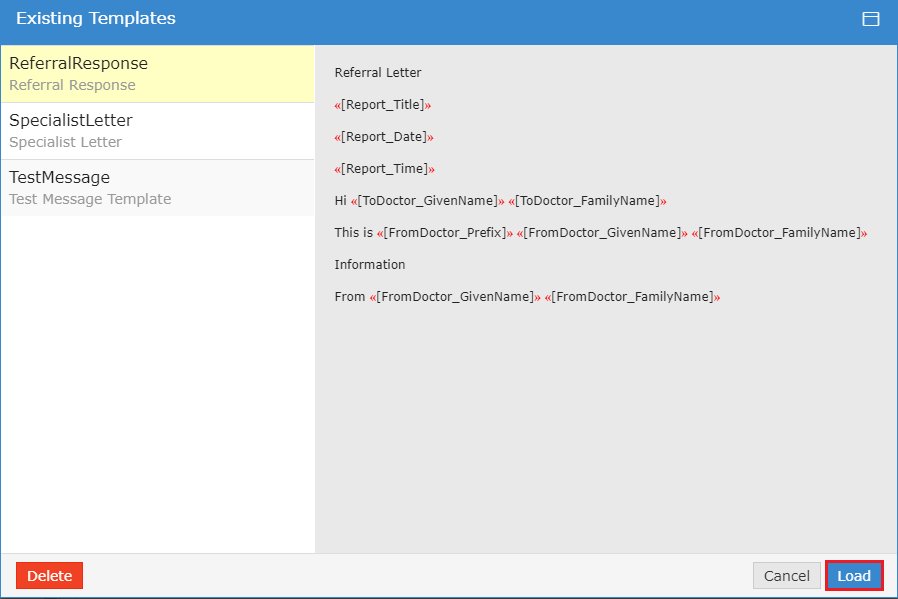
Make any changes that you wish to make, and then click the Save Template button in the bottom right, exactly how you would save a new template.
Deleting a Template
Click the Load Template button.

Then, select the template you wish to delete, and then click the Delete button in the right hand corner of the new screen.
The Activity Report allows you to view the transaction history of both incoming and outgoing documents. You can access the Activity Report via the Reports top menu option. When selecting the Activity Report menu option you will be presented with a window listing the report filtering options available. These will help you narrow the report down to only the documents you're interested in. By default, the filter options will show the current daily activity. You can leave it at that or you can click on the drop down button next to the end date to select a pre-defined range. The status of the document. The most common are; This is a timestamp for when the document was delivered. It does not necessarily mean that the document has been viewed or reviewed - only that it has been delivered. If this field is blank then the document has not been delivered. This column allows you to know whether or not the document has been acknowledged. To see what each icon in this column means; refer to the ACK Legend that can be found in the top right. Hover your mouse over each icon for a description. You can view a single document by clicking on the view document icon ( From this window you can perform various actions on the single document such as print, forward or loading the patient file via the All Documents button. You can also navigate to other documents via the back and forward buttons in the top right. You can select multiple documents in the grid and then perform an action on the selection. Currently the bulk actions available are;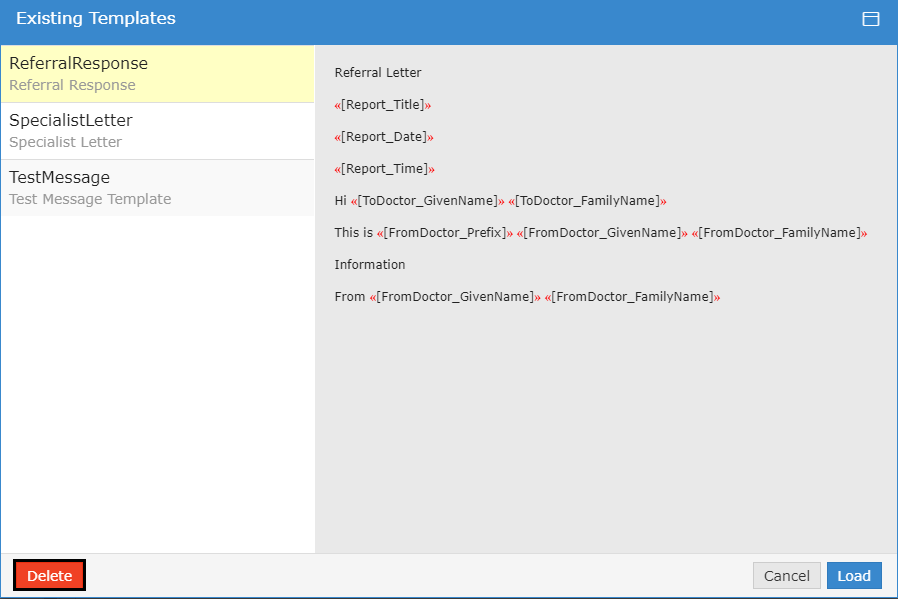
Activity Report


Understanding the report
Date The date the document was created. Patient Patient name. SURNAME, First name (Date of Birth) Recipient The provider the document was addressed to. Report Title The document title. Author The provider that authored the document. To Practice The server name of the practice that the document was sent to. This is generally the practice name. Status Delivery Type The software of the recipient that received the document. Delivered Reviewed The document has been marked as reviewed at the receiver's end. This column will only be populated if the receiver's Delivery Type is EQUATORDXTRAY. If not then it's best to look at the ACK column for an indication if the document has been acknowledged. ACK 
View Clicking the icon in this column will display the document. Viewing documents in the report
![]() ) in the View column of the grid. This will open the document in the document viewer window.
) in the View column of the grid. This will open the document in the document viewer window.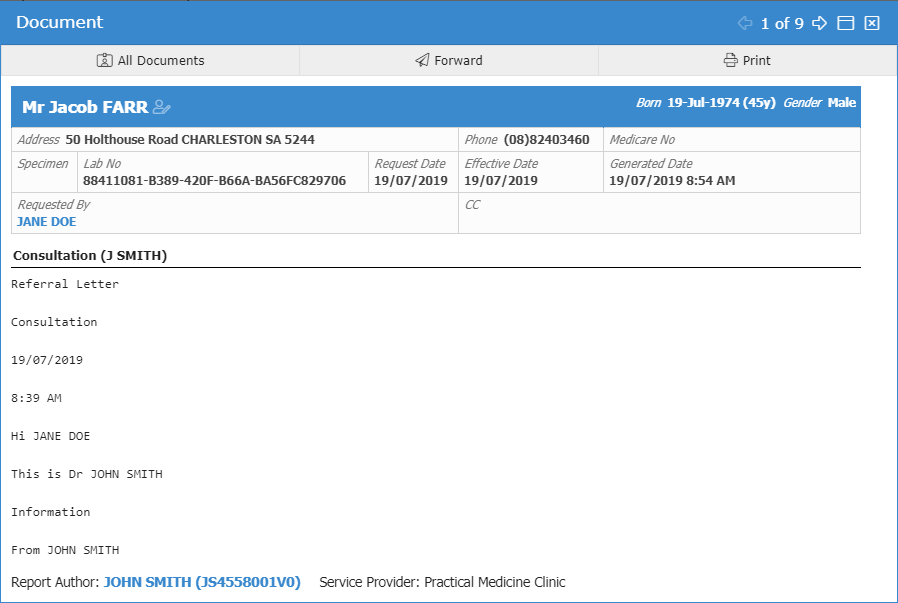
Bulk Actions
- No labels
